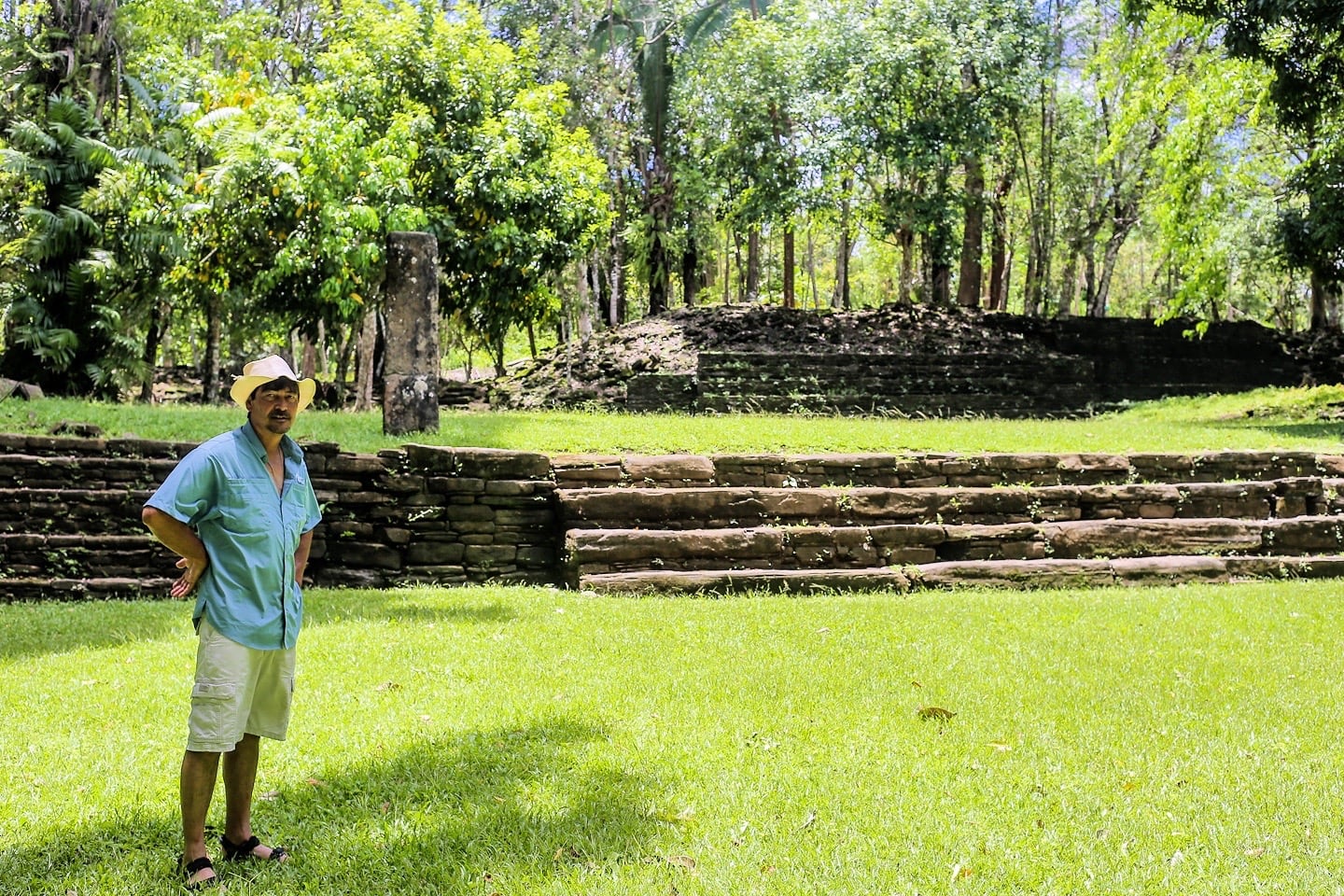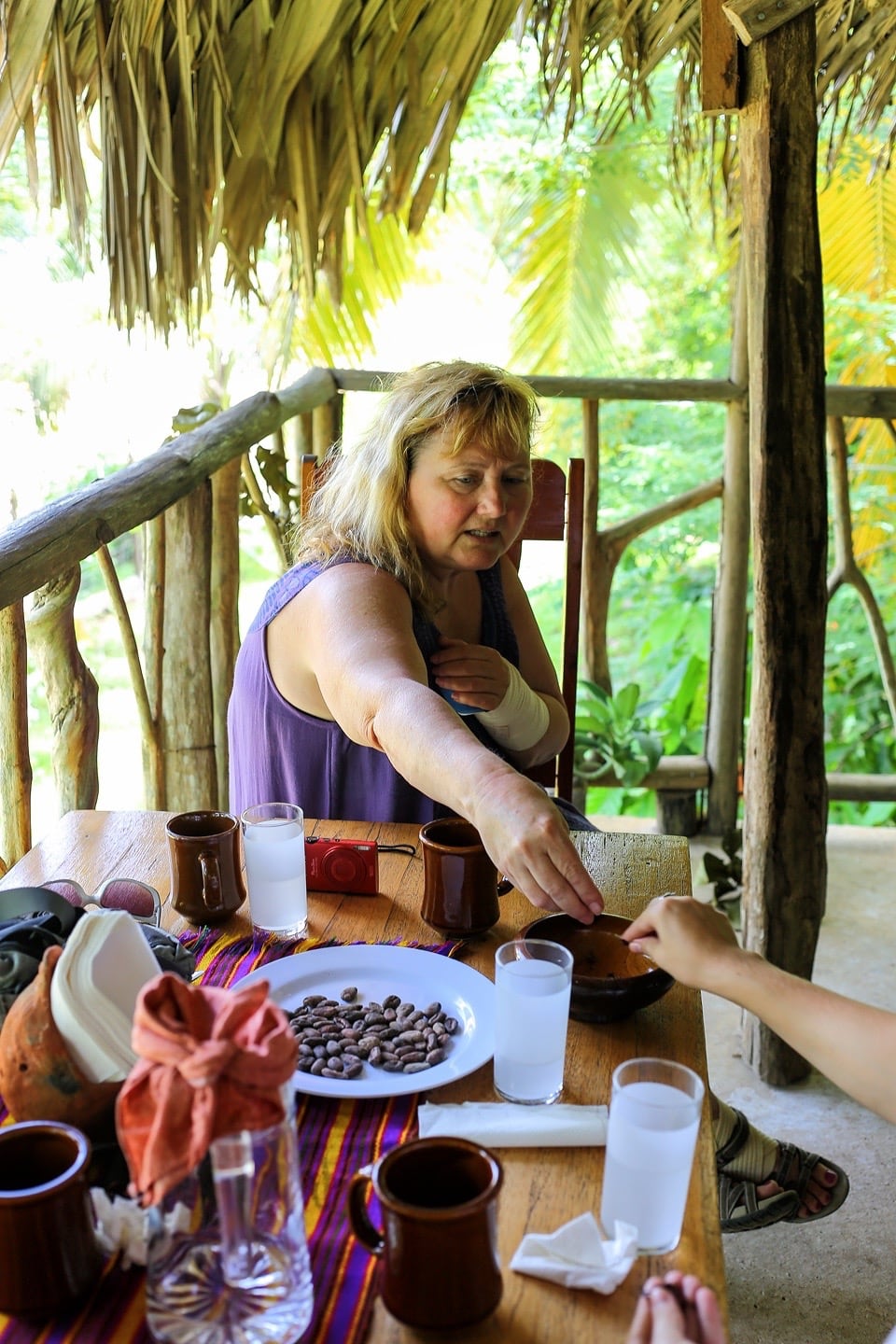
View of Toledo valley stretching to the Caribbean from the Nim Li Punit visitor’s center.

While there are several Mayan archaeological sites in Toledo, Nim Li Punit and Lubuntuun attract most of the visitors. Though the two sites pale in comparison to their cousins Caracol, Lamanai and Xunantunich up north, Nim and Lub are still worth exploring.
Nim Li Punit may be the easiest of all of the Mayan ruin sites in Belize to access, as it’s right off the very nicely paved Southern Highway, and that’s where I took my dad on this particular day.
Nim Li Punit’s got a nice collection of stone structures, stelae and a ballcourt, all shaded by well-maintained jungle canopy. There’s a good museum in the visitors center near the parking area that is also worth a look.

Walking around the site, you’ll get your daily dose of Gumbolimbo, Cohune palms, and jippy joppa, along with an earful of melodious singing from a variety of native bird species.
Most of the site dates to the Maya Classic Period, with the majority of activity occurring in the 8th century AD.

After exploring the ruins, we took a drive out on the new highway to Guatemala (still a work in progress — 10 miles shy of the border, but perhaps a lifetime away from meaningful completion), past San Antonio, through the village of Santa Cruz and stopping at Rio Blanco National Park.
It’s a scenic drive, certainly worth doing in and of itself. It’s also an excellent opportunity to observe the wheels of development (along with the various benefits and detriments) in motion, given that the brand new, pristine highway cuts through what were some of the most remote villages in Belize just a few years back. In a matter of years, the property and farmland of the local residents will become prime real estate on the main southern thoroughfare to Guatemala City, bringing 18 wheelers, tourists and anything and everything else. The highway will undoubtedly bring job opportunities for some, but others will lose land and livelihoods. Many will get very rich off of the new link, but likely not many of the current residents. The improved infrastructure will likely offer better access to medical care and shopping, but also new health risks and social ills. Time will tell how these communities and the Belizean government manages the transition.

Rio Blanco falls is a popular attraction for both locals and visitors in Toledo. Lori and I first visited the falls at the beginning of April, when it was barely a trickle off of the right side feeding a clear and refreshing pool. There’s a rock that is also popular for jumping off of, but the water line was too low in April.
Fast forward two months and Rio Blanco is already swelling from every corner. We did have a bit of rain prior to our recent visit, but I really had no idea how full the falls would be and was not prepared for the tremendous amount of water plunging over the limestone boulders. We had planned on an afternoon swim, but somehow thought it might not be the best day to do so. Either way, the view was very cool.




Friday morning, my parents and I took a drive out to San Felipe to see Hillside Clinic in action during one of their mobile clinics in the village, before meeting up with Lori and the rest of the Hillside crew for lunch across the street at Ixcacao (formerly Cyrila’s) Chocolate. It was the last day of a four-week rotation for the Hillside students, and following tradition, the group was treated to one of the tastiest local lunches anywhere in Toledo, as well as a cacao demonstration and tasting.

Juan and Abelina Cho own and operate the multi-generational establishment and are passionate about their family’s heritage and craft. In terms of taste and quality, Ixcacao’s chocolate is hard to beat anywhere. To top it off, they use nothing but local, natural ingredients from their own farm and nearby communities.
After lunch, Juan demonstrates how his ancestors have been making chocolate for centuries, with the traditional mano and metate hand-grinding method. Then, Juan leads the group downstairs for a tour through their current process and chocolate-making facility — but not without a sampling of the goods and opportunity to buy your own.

In raw form, cacao beans reside in pods, and are gooey and sweet with a bitter crunchy inside. They must be dried, fermented and roasted to obtain the cacao bean that is used to make the type of chocolate we’re familiar with.

During the demonstration, the group is invited to help in the process of making their own chocolate by peeling freshly roasted cacao beans, then taking their turn at the mano and metate.

It looks easy, but as Juan explains, the liquifying process takes heat, and heat takes muscle power. Making chocolate the old fashioned way is hard work, but with a sweet payoff.

Perhaps because I’m just plain mean and don’t want to leave you with photos of mouthwatering handmade Mayan chocolate, I thought I’d offer up something that to me was very cool — A local fix for a cracked toilet tank using local supplies…and it works like a charm! Pure genius. But I’d expect nothing less from the land that gave the world chocolate.





More great stories and pictures to enjoy. Thanks!